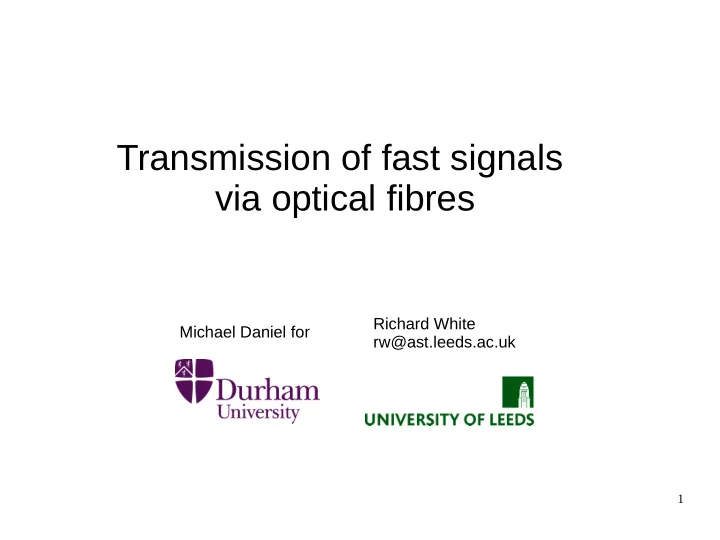

Transmission of fast signals via optical fibres Richard White Michael Daniel for rw@ast.leeds.ac.uk 1
Digitizing the signal from an IACT camera: why fast signal transmission is needed. ns The Cherenkov light front is ~couple nanoseconds in duration. After passing through Davies-Cotton optics this will be broadened to ~4.5ns rise time after 100m of co-ax. cable pulse rise time is ~8-10ns 0 10 20 30 40 [ns] want to maintain fast pulse rise structure, for timing information and to integrate signal with as small a time window as possible to enhance S/N ratio against night sky background 2
Advantages of an optical fibre system ➢ Less attenuation/dispersion of signal ➢ No cross-talk or electromagnetic pickup between channels ➢ Isolated from grounding problems ➢ Immune to lightning strikes ➢ Reduce weight ➢ Reduce costs, e.g. through multiplexing. 3
VCSEL - V ertical C avity S urface E mitting L aser VCSELs are high-bandwidth and low cost lasers, suitable for transmitting both digital and analogue signals. Analogue – PMT signals are transmitted with virtually no attenuation over fibre. Digital – versatile system for clock/trigger/housekeeping distribution. 4
fibre optic solutions used in IACTs ~2000 – Leeds & MPIK develop prototype for use in the outer 111 pixels of the Whipple 10m 490 pixel camera. Problem of VCSEL mode hopping leading to ~50% variations in the optical signal output on minute timescales. ~2004 – MAGIC camera is the first stable, large scale, VCSEL based analogue signal transmission system. Quality control means selecting the best VCSEL for use in the camera. VCSEL manufacturing has improved, but still ~30% are rejected to keep a reasonable ~12% spread in output pulse area and amplitude. An expensive cooling system is required in the camera to keep output constant from temperature fluctuations to 1C, but fibres allow multiplexing of pixel signal into 2GHz FADCs, saving money. ~now – 'a temperature stable optical link for transmission of fast optical signals' NIM A 595 , 332 (2008). Further VCSEL manufacturing improvements meant that none were rejected in this prototyping phase. 5
The Latest VCSELs • Apply Bias Current -> Measure Aout, %Noise -> Increase Bias Current. NEW VCSELS OLD VCSELS No Mode Mode Hopping, Lower Hopping Noise 6
The Leeds VCSEL-based transmitter circuit 850nm VCSEL has rise/fall times as short as 100ps and can be operated up to 200mA over short duty cycles (large dynamic range for Cherenkov pulses) RJ45 E2000 digital R laser driver BNC inject 0->2.2V pulse 7
The Leeds VCSEL-based transmitter circuit signal dispersion input pulse of 6ns duration & 1.8ns risetime after optical fibre link risetime is 3.2ns and FWHM is 6ns after co-ax. cable risetime is 4.3ns and FWHM is 8.3ns 8
The Leeds VCSEL-based transmitter circuit linearity & noise The linearity directly determines the usable dynamic range of the optical link – with the output pulse being linearly related to the input pulse. The lower limit of the dynamic range is related to the noise in the system, so the amount of noise introduced into a pulse at a given I b and T is understood 2mV to 2.2V pulse with FWHM of 5 ns and link at 20C Dynamic range of ~1100 with maximum deviation of 12% from linearity signal/noise for a range of temperatures and I b 9
The Leeds VCSEL-based transmitter circuit frequency response transmitter alone has bandwidth of ~ 470 MHz receiver currently limits this to ~ 250 MHz cf co-axial cable bandwidth of ~150MHz I b = 6mA T = 20C 10
The Leeds VCSEL-based transmitter circuit temperature correction 50C light output is relative to I b As T varies, R varies, thus I varies -10C 50C A digital resistor chip is loaded with a lookup of resistance vs T to adjust I b to maintain a gain equivalent to that at 0C. -10C 11
inter-telescope communications ● telescopes talking to the central trigger ● telescopes talking to each other (e.g. when using inter-telescope timing for large impact distance showers). 12
inter-telescope communications Telescope trigger only 1 bit – 10kb/s – ~10kHz 13
inter-telescope communications Telescope trigger + image location 16 bits – 1Mb/s – ~100kHz X X X 14
inter-telescope communications Untriggered stream of image characteristics 10Gb/s – ~1GHz 15
inter-telescope communications Untriggered stream of pixel data (2000 pixel camera) 1Tb/s – ~100GHz 16
inter-telescope communications Untriggered stream of pixel data (2000 pixel camera) 1Tb/s – ~100GHz but just 1 pixel ~100MHz 17
The Leeds D igital A synchronous T ransceiver ( DAT) Used by VERITAS for deadtime free transmission of asynchronous signals from telescope to central trigger & vice versa. 18
The Leeds D igital A synchronous T ransceiver ( DAT) Leading edge arrival time 95% of pulses arrive in ±0.265ns of that channel's average. Minimum transmittable pulse width is 5ns giving maximum transmittable data rate of 200MHz 19
The Leeds D igital A synchronous T ransceiver ( DAT) T3 Autocorrelations signal via DAT Also used in optical signal correlator tests between discriminated central pixel triggers of VERITAS telescopes. signal via co-ax - 60Hz pickup. 20
Summary Signal transmission via optical fibre offers many advantages over traditional co-axial cable. Reliable, high bandwidth solutions for signal transmission are becoming available (though bandwidth is currently receiver limited). 21
Recommend
More recommend